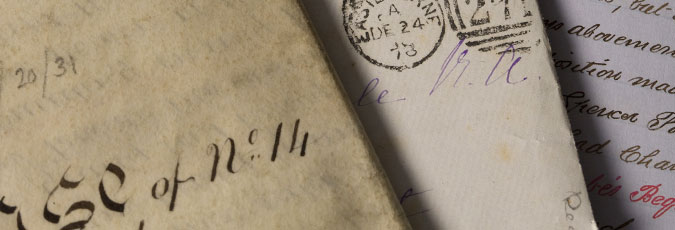A collaboration between the National Gallery and the Getty Research Institute
Between 2009 and 2016, the National Gallery undertook a two-phase collaborative project with the Getty Research Institute, Los Angeles, to augment records about British art sales in the period from 1680 to 1800.
The Getty Research Institute’s Project for the Study of Collecting and Provenance has been conducting research into European art sales since the 1980s, notably in relation to sales catalogues from major cities in Great Britain, France, Germany, Belgium, the Netherlands, and Scandinavia from 1650 to 1840. The contents of these sales catalogues are available online through the Getty Provenance Index® databases.
This data allows researchers to track patterns of taste in order to understand better cultural transfers, and to explore more fully the power of art markets. New knowledge about the history of the art market also promotes interdisciplinary exchange among scholars from a variety of fields, including art history, economics, and cultural studies.
Overview
In relation to British art sales, Getty Provenance Index® had concentrated its earlier research on early nineteenth-century British records. By comparison, little attention had been paid to British art sales of the late eighteenth-century, despite them being a crucial part of the history of the developing art market in London. Countless important art collections, including the celebrated Orléans collection, were dispersed throughout Europe, in auction sales from the 1790s, as a result of the disruptions caused by the French Revolution and the subsequent Napoleonic Wars. Since many of these auctions took place in Britain’s capital city, London developed into a major import market and soon established itself as the hub of the international art trade.
This big gap in knowledge prevented meaningful analysis into the art markets of Great Britain, into the continuing lives of dispersed French collections, and – due to the interconnectedness of national art markets – into the development of cultural networks throughout Europe. In order to rectify the situation, the National Gallery and the Getty Research Institute forged a two-part, jointly-funded collaboration to discover relevant British sale catalogues and to enter them into the Getty Provenance Index®, thus significantly augmenting knowledge of the historical British art market as well as the coverage of British materials in the Index®.
The research
The research team worked with many institutions to find, consult and photograph relevant holdings of catalogues from the period, capturing data concerning works of art, sellers, buyers and prices. Among archives and libraries in London, data was retrieved from annotated auction catalogues held by the Wallace Collection, the British Library, the British Museum, the Victoria & Albert Museum, the Courtauld Institute and the National Archives at Kew, as well as from the National Gallery’s own substantial holdings of historic sales catalogues.
In addition, the team sourced catalogues from numerous regional UK record offices, local archives and university collections, including the Barber Institute of Fine Arts, Birmingham; the Fitzwilliam Museum, Cambridge; and the Ashmolean Museum and Bodleian Library, Oxford. The researchers also received assistance from various foreign institutions, notably the Bibliothèque Nationale de France, Paris; the Hermitage Museum, St Petersburg; and the Rijksbureau voor Kunsthistorische Documentatie, The Hague.
Outcomes
British Sales, Phase I: 1780–1800: The first collaboration between the National Gallery and Getty Research Institute, which took place between October 2009 and August 2012, concentrated on British art sales from 1780 to 1800. It captured 104,717 records from 1,228 catalogues.
British Sales, Phase II: 1680–1779: The second collaboration, which took place between August 2014 and the Autumn of 2016, recorded the first hundred years of British art sales, from the earliest extant auction catalogue of 1682 up to 1779. As a result, another 137,965 records from an additional 1,087 catalogues were added to the Getty Provenance Index® databases. The collaboration drew on research already undertaken by Dr Richard Stephens and other colleagues who worked on the ‘The Art World in Britain 1660 to 1735’ project, launched by the University of York in 2011, to publish primary sources and research tools for the study of the arts in late seventeenth and early eighteenth centuries.
As a result of the National Gallery/Getty’s two-phase research collaboration, 242,682 new records from 2,315 catalogues were added to the British art sales on the Getty Provenance Index®. This new data, when combined with the Getty’s existing 19th-century records (1800–1840), means that the Getty’s British art sales databases now cover a continuous span of British sales from 1680 to 1840, the critically important period when Britain consolidated its dominant position in the European art market.
Conference: ‘London and the Emergence of a European Art Market (c. 1780-1820)’, London, 21–22 June 2013
To highlight some of the fruits of the collaboration between the National Gallery and the Getty Research Institute, as well as to promote further research in the field, the two institutions organised a symposium at the National Gallery on 21–22 June 2013: ‘London and the Emergence of a European Art Market (c. 1780–1820)’. The theme of the conference was the European art market of the later 18th century, and in particular, the ways that the market operated at a national and international level and its impact on the history of collecting and taste in public and private spheres, especially in Britain.
Publication: Susanna Avery-Quash and Christian Huemer, eds, 'London and the Emergence of a European Art Market, 1780-1820' (Los Angeles: Getty Publications, 2019)
This volume, arising from the 2013 conference with some additional contributions, illuminates London’s role in the development of a European art market at the turn of the nineteenth century, exploring the commercial milieu of art sales and collecting at this turning point as well as artistic tastes of the time. Its authors make use of a diverse range of methodological approaches, ranging from traditional art historical and provenance studies to statistical and economic analysis to question previous assumptions and consider previously overlooked commercial contexts.
Susanna Avery-Quash (August 2019)

